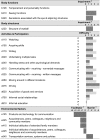What explains health in persons with visual impairment?
- PMID: 24886326
- PMCID: PMC4020575
- DOI: 10.1186/1477-7525-12-65
What explains health in persons with visual impairment?
Abstract
Background: Visual impairment is associated with important limitations in functioning. The International Classification of Functioning, Disability and Health (ICF) adopted by the World Health Organisation (WHO) relies on a globally accepted framework for classifying problems in functioning and the influence of contextual factors. Its comprehensive perspective, including biological, individual and social aspects of health, enables the ICF to describe the whole health experience of persons with visual impairment. The objectives of this study are (1) to analyze whether the ICF can be used to comprehensively describe the problems in functioning of persons with visual impairment and the environmental factors that influence their lives and (2) to select the ICF categories that best capture self-perceived health of persons with visual impairment.
Methods: Data from 105 persons with visual impairment were collected, including socio-demographic data, vision-related data, the Extended ICF Checklist and the visual analogue scale of the EuroQoL-5D, to assess self-perceived health. Descriptive statistics and a Group Lasso regression were performed. The main outcome measures were functioning defined as impairments in Body functions and Body structures, limitations in Activities and restrictions in Participation, influencing Environmental factors and self-perceived health.
Results: In total, 120 ICF categories covering a broad range of Body functions, Body structures, aspects of Activities and Participation and Environmental factors were identified. Thirteen ICF categories that best capture self-perceived health were selected based on the Group Lasso regression. While Activities-and-Participation categories were selected most frequently, the greatest impact on self-perceived health was found in Body-functions categories. The ICF can be used as a framework to comprehensively describe the problems of persons with visual impairment and the Environmental factors which influence their lives.
Conclusions: There are plenty of ICF categories, Environmental-factors categories in particular, which are relevant to persons with visual impairment, but have hardly ever been taken into consideration in literature and visual impairment-specific patient-reported outcome measures.
Figures
References
-
- World Health Organization. International Statistical Classification of Diseases and Related Health Problems. Geneva: World Health Organization; 2001.
-
- Laforge RG, Spector WD, Sternberg J. The relationship of vision and hearing-impairment to one-year mortality and functional decline. J Aging Health. 1992;4:126–148. doi: 10.1177/089826439200400108. - DOI
-
- Ash DD, Keegan DL, Greenough T. Factors in adjustment to blindness. Can J Ophthalmol. 1978;13:15–21. - PubMed
MeSH terms
LinkOut - more resources
Full Text Sources
Other Literature Sources
Medical



